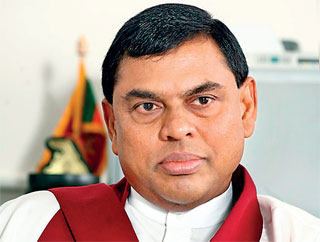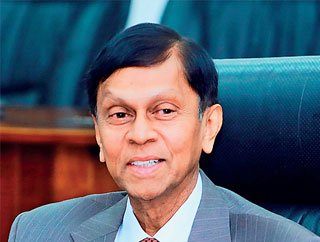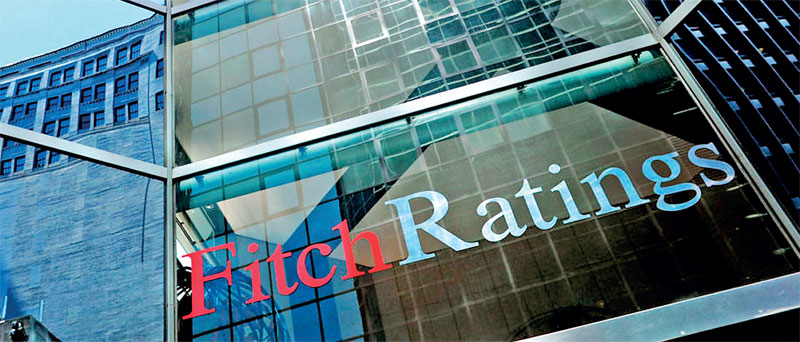Monday Apr 28, 2025
Monday Apr 28, 2025
Monday, 27 December 2021 01:31 - - {{hitsCtrl.values.hits}}

Finance Minister Basil Rajapaksa

Treasury Secretary Sajith Attygalle

Central Bank Governor Nivard Cabraal

Fitch had given sufficient notice to Sri Lanka’s Central Bank and the Ministry of Finance of its intended rating action
|
Aseni, the wiz kid in economics, is in conversation with her grandpa, Sarath Mahatthaya, a former employee of the Ministry of Finance on the recent downgrade of Sri Lanka’s international borrowings from CCC to CC by Fitch Ratings, one of the three main rating agencies in the world. Aseni has read the press release issued by Fitch Ratings and the response of the Central Bank to the downgrade. The following is the discussion between the two:
 Aseni: Grandpa, last week one of the rating agencies, Fitch Ratings, delivered a shock to Sri Lanka by downgrading the rating status of the country’s long term market borrowings from CCC to CC. Can you tell me what this means?
Aseni: Grandpa, last week one of the rating agencies, Fitch Ratings, delivered a shock to Sri Lanka by downgrading the rating status of the country’s long term market borrowings from CCC to CC. Can you tell me what this means?
Sarath: I don’t want to term it as a shock because it was quite expected for some time. Fitch had given sufficient notice to Sri Lanka’s Central Bank and the Ministry of Finance of its intended rating action. The market, especially which is outside Sri Lanka, had expected this downgrade if no remedial action, acceptable to investors, is taken by these two authorities. In a way, you can say that they had been put on notice.
But both the Central Bank and the Ministry of Finance failed to take notice of this warning. As a result, the country’s situation began to deteriorate month after month. Hence, instead of calling it a shock, I would like to call it Fitch’s punishment for failing to correct ourselves. But Fitch is not alone in this. The other two rating agencies, Standard and Poor’s and Moody’s too had punished Sri Lanka previously in this manner.
Aseni: Wow! I didn’t know about it. How did it happen?
Sarath: Anyone interested in borrowing from international markets is required to get his borrowing rated by at least two rating agencies. Rating is simply an expression of opinion by a rating agency about the possibility of a borrower defaulting the payment of interest and or the repayment of the principal on the due dates. Before expressing this opinion, the rating agency does a thorough independent audit of the borrower’s financial status. It is a thorough audit covering the borrower’s political stability, macroeconomic stability, state of the fiscal policy, monetary policy, governance track record, to mention but the important parameters used.
They make lengthy consultations with the top officials of the central bank, ministry of finance, top ministers, and also private sector stakeholders. Their findings are then presented to the officials of the central bank and the ministry of finance for response. The final rating action is announced only after such response is heard.
The present rating downgrade has been driven by three factors which the Sri Lankan Government cannot ignore. First Sri Lanka’s external liquidity position is worsening month after month. Second, this has been underscored by declining foreign exchange reserves. The third factor is the most pressing one. It is about the country’s inability to borrow from outside sources in adequate amounts to meet the foreign exchange commitments. It is like a man who has to make some payments, but he does not have any money with him and he cannot borrow from others to meet his payment commitments.
Before Fitch, Moody’s Investor Services also downgraded Sri Lanka’s long term foreign borrowings from Caa2 to Caa1 in last October. That was also a kind of a punishment meted out to Sri Lanka for bad behaviour.
Aseni: There is another rating agency, Standard and Poor’s or S and P that has been rating Sri Lanka? Have they also downgraded Sri Lanka?
Sarath: Not in the current cycle. But all the three rating agencies follow a similar pattern. Therefore, you can expect them too to follow the other two rating agencies in the days to come.
|
Aseni: Grandpa, has Sri Lanka been rated high in its rating history?
Sarath: No. Sri Lanka started its rating with Fitch and S&P in 2005, two years before it went for issuing its first International Sovereign Bond of $ 500 million in 2007. That was done as a preparation for the big event. But Fitch had rated Sri Lanka at BB- and S&P at B+ with a stable economic outlook. Fitch had given a higher rating to Sri Lanka by one notch. But both were below the minimum needed for an investment grade which is BBB-. The rating which Sri Lanka got was known as speculative or non-investment grade which is known as junk bonds or junkies in the terminology in the market. Even at that time, the two rating agencies had raised the issue of an unstable budget and a weak external sector.
The objective was for Sri Lanka to improve these deficiencies quickly so that the rating could also be improved. However, the things moved in the opposite direction. Soon, the stable economic outlook was changed to negative, and the rating was downgraded to B+ by Fitch and to B by S&P. So, in the junky category, Sri Lanka’s position further weakened. This happened in 2008. Since then, it was virtually a one-way journey for Sri Lanka, though in some years there was a marginal improvement in rating as well as in the economic outlook.
The third rating agency, Moody’s, had been rating Sri Lanka informally at around the same levels. They were officially engaged by the Government for rating purposes in November 2018. Now all the three rating agencies have downgraded Sri Lanka to a level at around CCC or CC levels. What has now happened is that Sri Lanka’s junky position has worsened to a junkier position. This is not a situation about which we can be happy at all.
Aseni: What are the implications of this downgrade of Sri Lanka?
Sarath: As I said earlier, the rating is simply expression of an opinion about a borrower’s capacity to meet all his debt obligations on time. When a country is downgraded, it gives an indication to existing as well as potential investors about the safety of the money which they have lent or are planning to lend to that borrower. It does not mean that investors should not lend to that borrower. They could lend after taking into account the risk involved. That risk factor is incorporated into the interest rate which they expect from that borrower.
You know that it is called the risk premium which a lender expects as the proper compensation of his taking that risk. With each downgrade, the risk premium which lenders expect from the borrowers concerned will also increase. Hence, a downgrade means that the borrower concerned will have to pay a higher interest rate to borrow money from international markets. It is a cost which a country has to incur when they borrow. Hence, it is the responsibility of the borrowing countries to improve on the deficiencies highlighted by rating agencies to have ratings upgraded. It helps them to cut the cost of their borrowings.
Another implication is that when a sovereign government has been downgraded, all the public sector institutions too will be downgraded to match the original downgrading. In Sri Lanka, this will affect the external credit rating of State banks. For instance, if the Government has got CC for its credit rating, the Bank of Ceylon cannot get a better international rating than CC. Hence, its rating too will be downgraded to CC which causes to increase the cost of its borrowings too. What this means is that in this credit rating game, all the public sector institutions rise together and fall together along with their government.
Aseni: People say that Sri Lanka’s outstanding sovereign bonds are presently traded in the secondary market at a deep discount. Is it the rating downgrade that has been responsible for that development?
Sarath: Technically yes, because the rating downgrade should increase the risk premium and yield rates. When the yields go up, the prices start falling. This is how the markets behave.
But the present trading of ISBs at a discount was not due to rating downgrades. The prices of these bonds started to fall from around February 2020 when the rating had not been changed. Before that, these bonds were traded at a premium meaning that their market prices were above the face value of the bonds concerned. But when the new Government offered an attractive tax reform program for VAT payers and income taxpayers, there was a general agreement that the Government will lose its revenue in the short to medium term. This was to cut the Government revenue by about 3% as a share of GDP from 12% to 9%.
The independent economic analysts had warned the Government as early as December 2019 that the Government will lose about Rs. 500 billion annually as a result of these tax concessions. This sound advice was ignored by the Government. Taking note of this adversity, the existing investors in Sri Lanka Government’s sovereign bonds started selling them in the market in a bid to exit these bonds. The result was the fall in the prices of these ISBs in the secondary market which converted the original premium position to a discount position.
However, in this instance, the investors were ahead of the rating agencies. Though the budget and the external sector had been showing distress signs from early 2020, the rating agencies did not think it necessary to cut the ratings. They did so in September 2020 long after the market prices of these bonds had fallen in the secondary markets. Today, they are traded at a deep discount indicting a substantial increase in the yield rates. As a result, the bonds that are to mature in 2030 are traded at around $ 55 to $ 60 at yield rates of above 20%. In the case of the bond to mature in January 2022, the price has fallen to about $ 88 with a yield rate of above 300%.
Hence, it is not the rating agencies that are to be blamed for the catastrophe. The market had been ahead of them, and they have simply followed the market. The Government should blame itself for this adverse market development. Because of these high yield rates ranging between 300% and 20%, the international sovereign bond market is completely closed for the Government. As a result, the Government cannot tap the ISB market to fill the gap in the balance of payments. That is why Sri Lanka is trying to get some short-term funding from friendly countries to fill the gap. But it is simply a temporary palliative and cannot take Sri Lanka out of the present malaise.
Aseni: Is there a way-out for Sri Lanka to improve its credit rating?
Sarath: Yes, and Fitch has suggested three such actions which Sri Lanka could take to improve its rating.
The first relates to the improvement in external financing. Fitch says that Sri Lanka should improve its external liquidity not by further borrowing but by non-borrowing. What this means is that any improvement in the foreign exchange reserves by going for SWAP facilities or borrowing from friendly countries as the Central Bank is presently doing will not be a sufficient reason for Fitch to improve the present rating at CC. They should be through non-debt sources like remittances, foreign direct investments or sale of assets to foreigners, for example.
The second is about the need for improving the Government budget. Fitch says that the Government should take action to consolidate the budget, meaning it should increase revenue, cut wasteful expenditure, keep the budget deficit at acceptable levels, and support a sustainable program to reduce the debt to GDP ratio. They are concerned about having more sustainable financing options for the Government to reduce the possibility of defaulting its loans.
Third, Fitch has said that there should be structural reforms introduced by the Government to assure coherence in and credibility of policies. Such a policy package will lead to the development of a good public and external financing system. It also reduces the risk of debt default which investors value so much.
Aseni: The ball is now in Sri Lanka’s court, isn’t it Grandpa?
Sarath: Yes, indeed. Instead of finding fault with rating agencies, Sri Lanka, like a good sportsman, should pick the ball and play the game now. When the way-out has been suggested, Sri Lanka’s Central Bank should advise the Government appropriately to go for those measures. To all outsiders, Central Bank’s spending time in designing counterarguments to demonise rating agencies is totally unproductive.
|
(The writer, a former Deputy Governor of the Central Bank of Sri Lanka, can be reached at [email protected].)
Discover Kapruka, the leading online shopping platform in Sri Lanka, where you can conveniently send Gifts and Flowers to your loved ones for any event including Valentine ’s Day. Explore a wide range of popular Shopping Categories on Kapruka, including Toys, Groceries, Electronics, Birthday Cakes, Fruits, Chocolates, Flower Bouquets, Clothing, Watches, Lingerie, Gift Sets and Jewellery. Also if you’re interested in selling with Kapruka, Partner Central by Kapruka is the best solution to start with. Moreover, through Kapruka Global Shop, you can also enjoy the convenience of purchasing products from renowned platforms like Amazon and eBay and have them delivered to Sri Lanka.
Discover Kapruka, the leading online shopping platform in Sri Lanka, where you can conveniently send Gifts and Flowers to your loved ones for any event including Valentine ’s Day. Explore a wide range of popular Shopping Categories on Kapruka, including Toys, Groceries, Electronics, Birthday Cakes, Fruits, Chocolates, Flower Bouquets, Clothing, Watches, Lingerie, Gift Sets and Jewellery. Also if you’re interested in selling with Kapruka, Partner Central by Kapruka is the best solution to start with. Moreover, through Kapruka Global Shop, you can also enjoy the convenience of purchasing products from renowned platforms like Amazon and eBay and have them delivered to Sri Lanka.